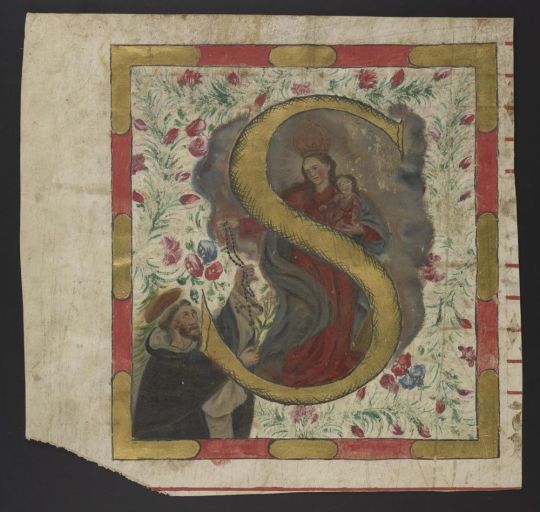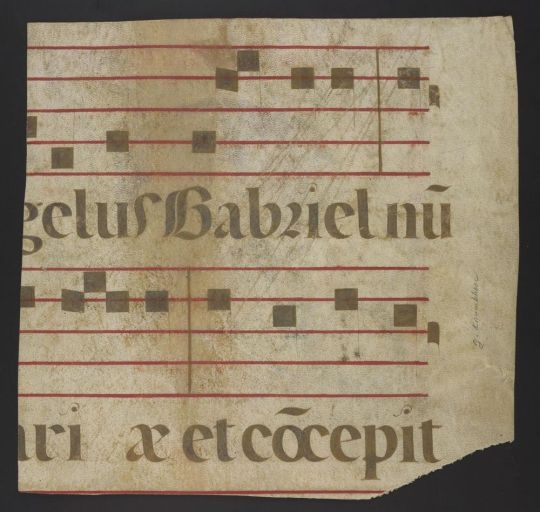#fragmentfriday
Explore tagged Tumblr posts
Text
Today’s #FragmentFriday is this printed book (published in Rouen around 1508) bound with fragments from 2 leaves of a 13th-century copy of the early encyclopedia De proprietatibus rerum, probably written in France. It's not unusual to see fragments in binding, but it is interesting to see the leaves folded instead of being trimmed. (UPenn LJS 395)
🔗:
92 notes
·
View notes
Photo

DACT Fragments@DactF·May 31
this #chant is #shiny ! & probably also really annoying to sing from if you are trying to actually do vespers for corpus christi. but, GOLD! (facing page must also have been pretty extra but it isn't at @HoughtonLib...) #fragmentfriday https://fragmentarium.ms/overview/F-y04u
0 notes
Photo

A wonderful mosaic of chocolate! Posted @withregram • @myic2016 Fragment Friday (since I missed my “Mosaic Monday” opportunity 🤷🏻♀️) . Some mould designs are so distinctive, just one look & you know exactly the maker. I likened this to celebrities that only need to go by a single name 😉How many of these moulds do YOU recognize? I’ll admit that a couple are vintage & have been replaced by newer ones 🤷🏻♀️ Also, two have a name or partial name emblazoned on them 🤣 . Do the 3D shapes impact your perception of taste? Some say yes! I certainly enjoy how the ridges & indentations interact with my tongue during a tasting 👅😲 . I hope you’ve enjoyed the Tangential Tasting Twin Tuesday #tttt_uniquemoulds theme - for me, it’s been so fun to see “old friends” and discover new ones 👏🏻 Have we missed any of your favorites?! 🤔 . #tttt_2021 #chocolatetasting #ilovechocolate #somanychocolates #craftchocolate #fragmentfriday #tttt_chocolate #chocolatesamples https://www.instagram.com/p/CUN8d-yDwQ_/?utm_medium=tumblr
#tttt_uniquemoulds#tttt_2021#chocolatetasting#ilovechocolate#somanychocolates#craftchocolate#fragmentfriday#tttt_chocolate#chocolatesamples
0 notes
Photo

Murmuration 🌳#Tinytober . It’s a bit late but I’m hanging in there!✨ - Thank you for all the interests in these pieces. I’m thinking of keeping some for a possible show and maybe put the rest up for sale at the end of the month, so stay tuned!💖 - #fragmentfriday #murmuration #starling #drawing #dreamgirl #allaboutface #minidreamer #pencildrawing #miniature #drawanyway #nightdreams #wip #workinprogress #worksonpaper #smallworks #traditionalart #ooak #originalart #instaart #artistsoninstagram #baopham #baophamart #baotpham #nightwork #lake #minidreamer #miniaturedrawing #graphite
#baophamart#artistsoninstagram#worksonpaper#starling#tinytober#baotpham#wip#minidreamer#smallworks#instaart#miniaturedrawing#workinprogress#traditionalart#lake#originalart#nightdreams#drawing#fragmentfriday#pencildrawing#baopham#miniature#drawanyway#dreamgirl#ooak#allaboutface#murmuration#nightwork#graphite
23 notes
·
View notes
Text
For #FragmentFriday this bifolium contains the continuous text of Psalms 44.5-47.15. It was originally part of a psalter probably written and decorated in the diocese of Seville, in southern Spain, in the early 13th century (UPenn Ms. Coll. 591, folder 17)
🔗:
#manuscript#medieval#illuminated#illumination#illuminated manuscript#spain#seville#13th century#fragment#fragment friday#bifolio#psalms#psalter#book history#rare books
71 notes
·
View notes
Text


Today's #FragmentFriday is this Flemish breviary leaf (written in Dutch), ca. 1480. One side has a 7-line initial in gold on a blue and pink background and a floral design also in gold, blue, and pink; the other has rubrication and two simple 2-line initials in blue. If you look carefully you can see the ruling lines
🔗:
Bonus video:
#medieval#manuscript#flemish#dutch#illuminated#rubricated#illuminated manuscript#fragment#fragmentology#leaf#book history#rare books
54 notes
·
View notes
Text




Today's #FragmentFriday is this 16th century collection of remedies, written in Italy, but the fragment is the binding! It's a parchment leaf from an unnoted hymnal, written in Germany in the mid 13th century (it includes a mention of St. Elizabeth of Hungary, who was canonized in 1235) (Ms. Codex 115)
🔗:
#medieval#manuscript#medieval manuscript#fragment#binding#hymnal#germany#fragmentology#13th century#book history#rare books
70 notes
·
View notes
Text
Form of… manuscript leaf! Shape of… envelope!
Today’s #FragmentFriday is Ms. Coll 591, folder 47, a leaf containing Alcuin’s instruction manual for the Christian catechism of pagan Saxons, folded into an envelope. France, 9th c.
🔗:
#medieval#manuscript#9th century#envelope#reuse#manuscript reuse#alcuin#theology#france#book history#rare books
46 notes
·
View notes
Text


For today's #FragmentFriday, a large historiated initial, possibly Spanish, cut from an antiphonary page. The initial shows Mary holding Jesus and giving a rosary to a saint, presumably Saint Dominic. The other side is a fragment of musical notation. The parent manuscript must have been quite large, used by a community rather than an individual. (Manuscript Fragment Collection, Ms. Coll. 591, Folder 15)
🔗:
#manuscript#18th century#antiphonary#liturgy#initial#historiated initial#musical notation#music#fragment#fragmentology#book history#rare books
40 notes
·
View notes
Text
Today's #FragmentFriday started out as a 14th century collection of laws, statutes and ordinances of Città di Castello, in Umbria in Italy, but more things were added in the 16th & 17th centuries: lists of holidays; roll of citizens by parish (parishes listed are St. Floridus, St. Jacobus and St. Egidius); record of fees collected, ranging in date 1514-1566; notarial documents; and more (Ms. Codex 91)
🔗:
#medieval#manuscript#fragment#fragmentology#fragment friday#14th century#16th century#17th century#italy#umbria#law#history of law#book history#rare books
42 notes
·
View notes
Text
Today's #FragmentFriday is fragments of accounts rendered by Guillaume de Salins to Mahaut d'Artois, Countess of Burgundy, from her properties in the County of Burgundy (Franche-Comté). It consists of three gatherings, is incomplete at the beginning and the end, and is badly stained. Fragments of the same accounts are found in three other manuscripts: Paris, Bibl. nat., ms. fr. 8551 and Besançon, Bibl. mun., mss. 914 and 914. (Ms. Codex 93)
🔗:
#medieval#manuscript#fragment#fragment friday#fragmentology#france#french#middle french#account#law#history of law#legal history#economics#medieval manuscript#14th century#book history#rare books
31 notes
·
View notes
Text


For today's #FragmentFriday, a leaf from a glossed Gospel of John, containing the text of John 7.25-39, written in northern France, probably Paris, in the 1200s. The Bible text is written in a formal Gothic script in the center column, with the gloss in a smaller script around it. There are also interlinear glosses between the lines of the Bible. (Manuscript Fragment Collection, Ms. Coll. 591, Folder 18)
🔗:
#fragment friday#manuscript#medieval#medieval manuscript#13th century#gospel#gospel of john#glossed#gloss#paris#france#bible#Gothic#book history#rare books
29 notes
·
View notes
Text


Today's #FragmentFriday is Ms. Coll. 591 Folder 10, a leaf from a 15th c. French breviary containing text from the Officium Beatae Mariae Virginis. Written in a Gothic hand, the text is laid out in 14 long lines with ruling visible. The left border on each side is decorated with floral traceries in blue and gold and the text is decorated with three 2-line initials of pink and blue on a background of gold. The dark line along the edge shows where the leaf was once glued onto a backing, only on one edge so the leaf could be viewed on both sides.
🔗:
#manuscript#medieval#medieval manuscript#illuminated manuscript#illumination#15th century#france#breviary#book history#rare books#art history
28 notes
·
View notes
Text
Today's #FragmentFriday is Ms. Roll 2062 #2, our second fragment from an 11th-century manuscript roll of the Liturgy of Saint Basil in the Byzantine Rite. Neatly written with headings and initials in gold; the parchment is tight and difficult to unroll.
Online: https://bit.ly/3TnovHg
#medieval#manuscript#fragment#roll#byzantine#greek#liturgy#liturgical#11th century#parchment#gold#illuminated#book history#rare books
58 notes
·
View notes
Text
Today's #FragmentFriday is from Ms. Codex 1572, an early 14th c. Italian Graduale. Front pastedown is from southern Germany, ca. 1400; back pastedown, from a 13th-century Italian missal. The front flyleaf was originally one of the last leaves. Online: bit.ly/3pfWQu7
#medieval#manuscript#binding#fragment#italy#gradual#14th century#germany#rare books#book history#asmr no talking
76 notes
·
View notes
Text
Today's #FragmentFriday is Ms. Roll 2062 #3, our third fragment from an 11th-century manuscript of the Liturgy of Saint Basil in the Byzantine Rite. Neatly written with headings and initials in gold; the parchment is tight and difficult to unroll
Online:
47 notes
·
View notes